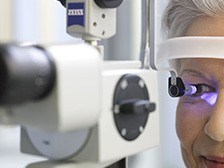Glaucoma
Glaucoma is a set of common, silent, eye diseases in which the optic nerve at the back of the eye is slowly destroyed. Eventually, it effects one in seven Australians and occurs more commonly in those with a family history of glaucoma.
Chronic Open Angle Glaucoma
Chronic open angle glaucoma is the most common type. Damage progresses very slowly and many effective treatments are available to retard its progress. The aim of treatment is to arrest progressive visual loss because damage that has occurred cannot be reversed. This is why it is important to check for the presence of glaucoma at least 3 yearly after age 40.
Glaucoma causes loss of vision from the gradual and accumulating death of fibres of the optic nerve, the nerve of sight. The eye, which contains no bone or cartilage, maintains its shape by being inflated by a fluid pressure. That pressure must be sufficient to hold the shape of the eye but not so high as to prevent bloodflow into the eye to nourish its internal structures. In glaucoma, excessively high pressure over time causes fibre death at the optic nerve head which loses its full pink appearance and becomes flat, excavated and white. Consequently, the width of the field of vision of the eye is lost, leading ultimately to tunnel vision in many end stage glaucoma cases.
Acute Angle Closure Glaucoma
Acute angle closure glaucoma is far less common and presents with sudden fogging of vision and pain. Early treatment of this type of glaucoma is usually very successful.
Diagnosis
Regular eye examinations are the best way to diagnose glaucoma. Testing for glaucoma includes, a thorough examination of the eye structure, measurement of the intraocular pressure, examination of the appearance of the optic nerve at the back of the eye and computerised testing of the width and completeness of the field of vision.
Treatment
Treatment involves regular eye drops, laser therapy and drainage surgeries. Currently, most treatment is aimed at reducing eye pressure, although by how much is a very individual thing. Healthy eyes may tolerate an above normal pressure provided they can be regularly monitored whereas a damaged eye may be compromised by a "normal" pressure.
In recent years, attention has moved on from the primary importance of eye pressure to consideration of the susceptibility of the nerve fibres to different pressures and of different fibres to the same pressure. Much excellent research is being done in these areas.
Glaucoma management is an ongoing individualised commitment between you and your eye specialist for many years.
